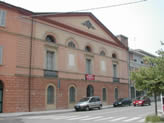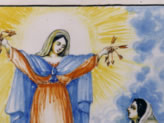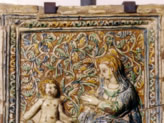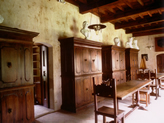Museo Civico San Rocco - Fusignano
Via Monti, 5 48010 Fusignano
Tel. 0545 51621 / 0545 955673 - 9556611 Fax 0545 50164
email comunefusignano@provincia.ra.it
web http://www.comune.fusignano.ra.it/Citta-e-territorio/Cultura/Musei
Apertura: da settembre a giugno, sabato, domenica e festivi, ore 15-18. Ulteriori aperture per visite guidate su appuntamento (telefonando all'URP al n. 0545 955653).
Chiusura: luglio e agosto, Natale, Capodanno
Parcheggio: lungo via Monti
Ingresso gratuito
Accessibile ai diversamente abili
Caratterizzate da svariate forme e dimensioni, le targhe ceramiche - per la maggior parte a carattere propiziatorio - sono espressione figurativa della cultura popolare religiosa, sia emiliano-romagnola sia di altre regioni italiane, con due pezzi provenienti dalla Spagna e dalla Francia.
Queste targhe erano murate sopra le porte d'ingresso o all'interno delle case di città, ma soprattutto in campagna per propiziare il soccorso della Vergine e dei Santi.
L'iconografia presenta in maggioranza raffigurazioni legate alla pietà mariana con una sorprendente ricchezza di soggetti, con titoli coniati dal popolo: Madonna delle Grazie, del Rosario, del Carmelo, del Buon Consiglio, della Cintura, dell'Angelo, del Conforto ecc. Vi sono inoltre targhe raffiguranti Santi invocati come protettori e ausiliari: S. Antonio Abate, S. Vincenzo Ferreri, S. Guglielmo, S. Cristoforo, S. Filomena, S. Antonio da Padova, S. Giuseppe. Due targhe ci presentano la Natività e alcune raffigurano la Sacra Famiglia e il Presepe.
Importante è anche la presenza di un ex-voto del XVII sec. in maiolica di Deruta con la scritta PER.GRA.TIA.REC.UTA., e di due rare targhe, una Madonna col Bambino di produzione riminese datata sul retro 1660 e una Madonna col Bambino prodotta a Montelupo datata sul retro 1661 e siglata P. A.
Le targhe con la data o databili per confronto, rivestono particolare importanza per lo studio della storia e l'evoluzione degli stili e per il contributo alla definizione delle tecniche esecutive. L'arco cronologico del corpus va dal sec. XVI a tutto il sec. XX e numerosa è la presenza di manifatture toscane.
Oltre alla raccolta di ceramiche devozionali, nei locali del piano terra troveranno collocazione a breve altre raccolte artistiche, mentre al primo piano il Museo organizza regolarmente mostre tematiche.
° ° ° ° ° ° ° ° ° ° ° ° ° ° ° °° ° ° ° ° ° ° ° ° ° ° ° ° ° ° ° ° ° ° ° ° ° ° ° ° ° ° ° ° ° ° ° ° ° °
The San Rocco Civic Museum, opened in September 2001, was created thanks to the donation of Professor Sergio Baroni, a well-known antiquarian and collector from Fusignano, who donated his splendid collection of devotional plaques to the municipal administration in honour of its parents Vincenzo and Amelia. The collection has expanded over the years with further precious donation from the townspeople who wished to follow Baroni's example, to conserve this moving testimony of folk art and make it accessible to all.
The Museum is settled up in the rooms of the ex-hospital of the town, a building used for around three centuries to care for pilgrims and the sick, and its precise date of establishment is not known. Having survived the turmoil of the First and the Second World Wars, when it had to be evacuated due to the constant bombardments on the front line, the hospital of Fusignano continued to provide care to the people until the Eighties.
The building has a very harmonious, noble and severe appearance. The upper floor is used for temporary exhibitions and was opened on the 60th anniversary of the death of the famous Fusignano bibliophile, Carlo Piancastelli.
Until a few decades ago, votive plaques were a common sight, built into the wall above the doors of houses, or inside the home, in a small niche in the wall or in the stables. It was just as common to see them set on pillars by the roadside, at junctions or on very old trees.
The term "plaque" describes its form, while the term "popular" refers to an aspect of religion which expresses private emotion.
No matter how it is made, every pillar it is tied to an individual or family destiny, recalling the history of a given place, and is always an expression of the efforts and fears of man who can do nothing other than put himself in the hands of the Heavenly Mother or a patron saint to find the comfort and strength to survive from day to day.
Despite is anticlerical reputation, Emilia Romagna is the region which has produced the most devotional plaques, especially during the eighteenth and nineteenth centuries. This high level of production was due to the great circulation of sacred images, engraved on paper, which many printers distributed through confraternities.
The Museum measures approximately 300 metres square on the ground floor and is divided into five sections: Emilia Romagna, Tuscany, Central Italy, Southern Italy, and a small local section.
The Romagna section dedicates plenty of space to the majolica of Faenza, a city which has been an important ceramics production between XVIII and XIX centuries.
The second room displays ceramics produced in the Tuscan cities of Siena, S.Quirico d'Orcia and Florence, with interesting pieces which are dated and which bear unusual iconographies. The same room houses a whole display case containing pieces of exquisite workmanship from the famous Ginori factory.
The central Italian section begins in the third room with various important plaques painted in Castelli d'Abruzzo and ends in the fourth with an entire display dedicated to the production of the Deruta factory and plaques from other areas.
The southern Italian section is in the third room and includes large panels of painted tiles and a characteristic Christmas crib from Caltagirone.
The fifth room features pieces from the local area, but also pieces from other areas donated by people of Fusignano. Of particular note is a painted slab showing The Saints John the Baptist and Saint Savino.
Finally there is a small didactic section in the Museum where visitors can study the process involved in producing the plaques, as reproduced by the students of the Ceramic Art Institute of Faenza.




